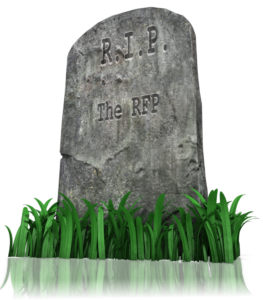RIP, RFP — This Is Not Your 1990s Vendor Selection Process
The RFP (request for proposal) is close to extinction. Let me explain why.
Companies use the RFP process to show that they have:
- Established comprehensive requirements.
- Considered and reduced risk.
- An objective and transparent decision-making process.
Makes sense, right?
Yes. If we were managing outsourced cost optimization models circa the 1990s, the RFP would still have its place. However, the world and technology have significantly moved on with the inception of digital business and customer-centric strategies.
Here’s what I’ve learned from the numerous vendor selection engagements that Forrester is asked to participate in and why this archaic and cumbersome approach no longer makes sense.
Technology buyers try to incorporate all things for all people. An extensive list of requirements focuses on known and current solutions. This does not satisfy modern digital business needs of innovation and agility. It promotes “digital sameness” (offering no competitive differentiation) and “new legacy” (with all the associated maintenance and support costs). Furthermore, prescriptive and restrictive requirements stymie the vendor’s ability to showcase their expertise and innovative approaches.
If you are trying to fill an expertise gap, why would you impose constraints on the vendors that would stop them from responding with flexible, creative solutions that address your needs? Don’t eliminate potentially viable partners through an exhaustive RFP.
RFPs are not aligned to business goals. Clients struggle to articulate how the solution should enable business goals and objectives or what the expected outcomes and benefits should be.
RFPs are expensive and time-consuming. Think about how long it takes for internal teams to develop and produce an RFP, then subsequently score the vendor responses (typically upward of three months). All this in addition to their “day jobs” proves to be a tedious and academic exercise. Clients typically only make their decision after vendors have displayed their ability to meet their use cases via a live demonstration. Through these live evaluations, clients understand if they can form lasting partnerships with the vendors, build mutual trust, and, most importantly, if vendors are aligned to their business goals and objectives, applying innovation to these business priorities.
Risk-averse models are incompatible with digital business. Gone are the days when you attempt to have the vendor absorb all the risk. That mentality of supplier management may have had limited effect for multi-million-dollar outsourcing deals but is no longer relevant in today’s digital age. Companies need to become risk-tolerant as they embrace startups and emerging technology vendors while ensuring that adequate controls and mitigation are in place.
The process is not always transparent or objective. Oftentimes, companies have a strong sense of which vendor they would like to engage with but use the RFP process to promote a fictitious sense of competitiveness between the preferred vendor and numerous hopeful challengers. Conversely, vendors have become smarter at identifying these instances and will not respond. Engaging the preferred vendor in an onsite demonstration or proof of concept is a more optimal way to approach this.
How should companies approach vendor selection in this modern, digital age?
Forrester has an accelerated approach to vendor selection that alleviates RFPs. Our “sourcing light” offering allows clients to:
- Make confident technology choices that maintain the right balance between service delivery, agility, innovation, and cost.
- Build customer-centric, sustainable partnerships aligned to business strategies and growth objectives.
To learn more about this approach to successful vendor selection, please reach out to me via an inquiry.

